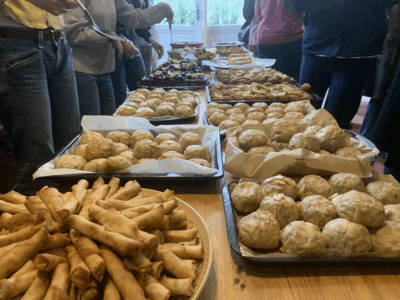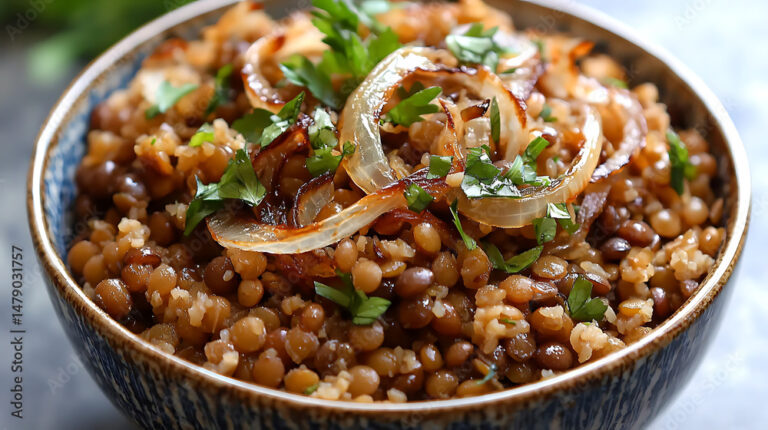


RPM's Syrian Culture Café - 2025
A feature from A Cookbook Without Borders by Abdulatif Askef
Food is a heritage proudly passed down through generations, where no two dishes are ever quite the same. It is, and always will be, a unifying force, a legacy that endures even through wars and natural disasters. Consider that the first recipes, inscribed on clay tablets from 1730 BCE, have survived.
So when we speak of food from a vibrant and ancient region like the Levant, particularly Syria, home to one of the world’s oldest continuously inhabited cities, imagine the complexity of its cuisine. Cultures from across the globe have left their imprint. The Silk Road brought spices from Asia and Africa, and diverse empires, such as those of the Phoenicians, Romans, and Umayyads, shaped its culinary landscape. The Umayyad Caliphate, with Damascus as its capital, drew people from all corners of the world, each contributing their own traditions. Similarly, Aleppo served as a cultural hub in the East for centuries.
This article will guide you in depth through the extraordinary food culture of the Levant and how it has been shaped by history up to the present day, with a specific focus on Syrian cuisine. So, together let’s delve into Syrian food history in detail.
To understand Syrian food, we must first consider Levantine cuisine, which encompasses Syria, Lebanon, Palestine, and Jordan. This culinary tradition boasts a history dating back to ancient civilizations. Archaeological evidence reveals that staples like wheat, barley, lentils, and chickpeas were cultivated in the region thousands of years ago.
Early civilizations, including the Phoenicians, Canaanites, and Romans, left their mark on the region, contributing to the development of advanced agricultural practices and culinary techniques. The Phoenicians, masters of the sea, had a significant influence on the Syrian and Lebanese coasts, spreading the cultivation of olive trees, and thus olive oil, as well as establishing many vineyards. The Romans, on the other hand, introduced elements of East and South European food culture, with different crops and new irrigation and farming techniques, and undoubtedly adopted local culinary influences that they carried back with them to the Mediterranean, forming a developed spice trade with ingredients such as the sumac, cumin and coriander.
Following the Roman era, the arrival of the Arab Umayyad Caliphate (661-750 CE), with its capital in Damascus, marked a significant turning point. This elevation of the region’s importance fostered a vibrant cultural exchange, with yet another influx of foreign agricultural products. In particular, the sophisticated Umayyad court likely influenced the evolution of more refined and elaborate dishes. From stuffed vegetables to early pilafs – rice cooked in broth with spices and garnished with nuts or meat – to pastries made with ingredients like nuts, syrup or honey (e.g. halva and qatayef), the Umayyad period laid the groundwork for many classic Levantine dishes we recognize today.
After that, the 400-years-long rule of the Ottoman Empire, ending in the early 20th century, also left an indelible mark on Levantine cuisine, introducing a wealth of dishes and culinary techniques stemming from Turkish and Central Asian traditions. Consider, for instance, the arrival of what would become the beloved shawarma in Damascus, likely originating from döner kebabs in Istanbul. Over time, local ingenuity adapted it, with distinct preparations and flavors like garlic sauce, citrus marinades and pickles.
After the Ottoman Empire’s fall and the Levant’s division into distinct countries by French and British mandates, the region’s intertwined culinary heritage became even more evident. Disputes over the origins of beloved dishes like hummus and falafel – think of the French-Belgium fry debate – serve as a testament to this shared gastronomic legacy. While each nation within the Levant proudly claims these iconic staples as their own, often leading to lively and passionate debates, the reality is that these dishes emerged from the collective culinary landscape of the region, evolving and being uniquely adapted by each country over time
Even within Syria itself, vibrant and friendly rivalries exist between cities. Just as nations might contest the origins of hummus or falafel, Syrian cities like Damascus and Aleppo harbor their own distinct culinary traditions, sparking playful competition. Aleppo, renowned for its sophisticated and diverse cuisine, proudly showcases dishes such as its unique variations of kibbeh – made from ground meat and bulgur wheat – and the flavorful cherry kebab. Meanwhile, Damascus, with its long history as a major cultural center, is celebrated for its exquisite sweets, like baklava, and its rich, flavorful stews. Further highlighting these internal culinary distinctions, the origin of the beloved sweet cheese dessert, Halawet el-Jibn, is fiercely debated between the cities of Homs and Hama, each having cultivated its own distinct and cherished version of this treat. Ultimately, Syrian cuisine has been intricately woven from centuries of history and cultural exchange. It is a cuisine that not only reflects the warmth and renowned hospitality of the Syrian people but also endures as a culinary treasure, continuing to delight and inspire with its depth and complexity.
The profound impact of Levantine food, shaped by millennia of history and cultural exchange, continues to resonate globally in remarkable ways. Take, for instance, the innovative and wildly popular Dubai chocolate knafeh. This decadent creation, a testament to the enduring appeal and adaptability of the classic Levantine knafeh, reimagines the traditional cheese pastry with a rich chocolate twist, showcasing the foundational influence of Levantine sweets on modern culinary trends in the Middle East and beyond. Or witness the worldwide phenomenon of hummus and falafel, staples that have transcended their regional origins to become celebrated as quintessential vegan fare, now readily available in supermarkets across the globe. It is a poignant reality, however, that the true origins and cultural heritage of these dishes are not always fully acknowledged. This underscores the vital importance of continued dialogue and recognition, for food is an inseparable thread in the rich tapestry of culture, as significant as any historical event, religious belief, or political shift.
Now, as we conclude this exploration of Syrian food history, I want to share with you a recipe for my personal favorite, and perhaps most underrated, vegan Syrian dish: Mujaddara – a dish that even sparks friendly debate within the region about whether it’s best prepared with rice or bulgur. Following my grandmother’s cherished recipe, you will soon understand its enduring appeal.

Mujaddara bil Burghul, a staple dish from the Syrian coast, particularly the historic port city of Latakia, offers a nutritious and deeply flavorful experience. This version of the classic Middle Eastern lentil and grain pilaf uses coarse bulgur wheat instead of rice, lending a distinct nutty flavor and satisfyingly chewy texture. The crowning glory of this dish is the abundance of deeply caramelized, crispy onions, which impart a sweet and savory depth that is truly irresistible. While specific regional variations abound, this recipe captures the essence of a traditional Syrian mujaddara with bulgur, a comforting and wholesome meal enjoyed for generations!
Yields: 4-6 servings
Prep time: 20 minutes
Cooking time: 45-60 minutes
INGREDIENTS:
* 1 cup brown or green lentils, rinsed
* ¾ cup coarse bulgur wheat, rinsed
* 3-4 large yellow onions (about 2 lbs/900g), thinly sliced
* ½ cup olive oil, plus more if needed
* 4 cups water or vegetable broth, plus more as needed
* 1 teaspoon ground cumin (optional)
* Salt and freshly ground black pepper to taste
* Fresh parsley, chopped (for garnish, optional)
* Plain yogurt or a simple Arabic salad (cucumber, tomato, lemon juice, olive oil), to serve (optional)
EQUIPMENT:
* Large heavy-bottomed pot or Dutch oven
* Large skillet
INSTRUCTIONS:
1. Caramelize the Onions (The Key to Flavor):
* In the large skillet, heat the ½ cup of olive oil over medium heat.
* Add the thinly sliced onions and a pinch of salt. Cook slowly, stirring occasionally, for 30-45 minutes, or until the onions are deeply browned, crispy, and significantly reduced in volume. Be patient with this step; the deep caramelization is crucial for the authentic flavor. If the onions start to burn, reduce the heat slightly.
* Once the onions are deeply caramelized and crispy, remove about half of them with a slotted spoon and set aside on a paper towel-lined plate for garnish. Leave the remaining onions and the flavorful oil in the skillet.
2. Cook the Lentils:
* While the onions are caramelizing, in the heavy-bottomed pot, combine the rinsed lentils with 4 cups of water or vegetable broth. Bring to a boil, then reduce the heat to low, cover, and simmer for 15-20 minutes, or until the lentils are partially tender but still hold their shape. Skim off any foam that rises to the surface.
3. Combine and Cook the Mujadara:
* Pour the remaining caramelized onions and all the olive oil from the skillet into the pot with the partially cooked lentils.
* Add the rinsed coarse bulgur wheat to the pot.
* Stir in the ground cumin (if using), and season with salt and pepper to your taste.
* If needed, add a little more water or broth to ensure the bulgur is just covered by liquid.
* Bring the mixture back to a gentle simmer. Cover the pot tightly, reduce the heat to the lowest setting, and cook for another 20-25 minutes, or until both the lentils and bulgur are tender and all the liquid has been absorbed. Avoid stirring during this time to allow the bulgur to steam properly.
4. Rest and Serve:
* Once cooked, turn off the heat and let the mujadara sit, covered, for at least 10 minutes. This allows the flavors to meld and the grains to fully absorb any remaining steam.
* Fluff the mujadara gently with a fork.
* Serve warm, garnished generously with the reserved crispy caramelized onions and a sprinkle of fresh chopped parsley, if desired.
* Mujadara bil Burghul is traditionally served with a side of plain yogurt or a simple, refreshing Arabic salad.
Tips for a Perfect Mujadara bil Burghul:
* Onion Perfection: Don’t rush the caramelization of the onions. This step is paramount for the deep, savory, and slightly sweet flavor of the dish.
* Bulgur Type: Ensure you are using coarse bulgur (often labeled as #3 or #4). Fine bulgur will result in a mushy texture.
* Lentil Choice: Both brown and green lentils work well. Brown lentils tend to soften more, while green lentils hold their shape a bit better.
* Flavor Boost: Some variations include a pinch of allspice or a bay leaf added with the lentils for extra aromatic depth.
* Make it Ahead: Mujadara often tastes even better the next day as the flavors continue to develop. It reheats well.
Enjoy this authentic taste of Syrian home cooking, a dish that is both humble and remarkably satisfying!
This article was written by Abdulatif Askef and edited by Alaïa Lafleur.